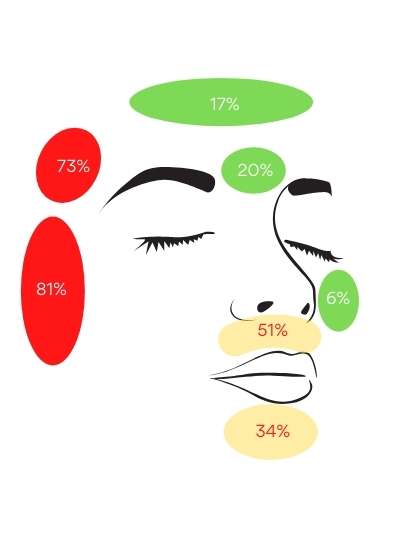Non-Surgical Hair Restoration Options

There is no easy treatment for hair loss (alopecia). Perhaps one day there will be a magic pill that will be a baldness cure. Until that day, we have to make do with a plethora of baldness treatments that have been advocated for hair loss. These include prescription oral medications, over the counter medications, herbal treatments, and many shampoos, creams, and ointments. It turns out that very few of these have good evidence of efficacy even though every product will claim to have some anecdotal evidence. In our Edmonton clinic, dermatologist Doctor Thomas Nakatsui is a true skin and hair expert and will be able to give you the best advice on your hair restoration options.
1. Minoxidil 5% foam or lotion (Rogaine)
In studies where hundreds of men with androgenic alopecia (male pattern balding) used minoxidil, not everyone with male pattern baldness responded by growing hair. However, some did grow hair, particularly in the vertex of the scalp or crown and in others the balding process was delayed with growth of new hair equalling loss of old hair. Women with female pattern baldness (androgenic alopecia) also respond to Rogaine.
Although Rogaine does not typically cause side effects, it can cause irritation of the scalp, fast heartbeats, dizziness, or lightheadedness. If you get any of these side effects, you should stop this hair restoration medication.
At this point, it is still not precisely known how Rogaine works. Although it dilates blood vessels and many doctors may say this is how it helps hair loss, this is not thought to be how it helps hair growth. It is more likely related to the effects of minoxidil on cellular potassium channels. As a result, minoxidil is a non-specific stimulator of hair growth and can be used for male pattern balding, female pattern hair loss, as well as other types of alopecia, including alopecia areata. Some patients have used oral minoxidil to regrow hair. Unfortunately, one of the side effects of oral minoxidil is excess facial hair.
Patients frequently need to use Rogaine for at least 9 months to see a difference.
2. Finasteride (Propecia, Proscar)
Finasteride has helped many men slow down their androgenic alopecia significantly, and some men regrow significant amounts of hair on this medication. It can be a very useful hair restoration option. Side effects of finasteride are few, but some of the potential side effects include decreased sex drive and gynecomastia. Finasteride is also known as Propecia or Proscar, and is a 5-alpha reductase inhibitor. We have found finasteride to be a useful adjunct to hair transplantation patients as it helps men retain the hair they have. Read our latest blog post about finasteride here.
Some women have also been put on finasteride for androgenetic alopecia, although the studies to date have not conclusively shown reliable benefit. Nevertheless, some women may benefit from this medication.
3. Dutasteride
Dutasteride (also known as Avodart) is also a 5-alpha reductase inhibitor and is a cousin to finasteride. It can also be used to help fight androgenic alopecia. Dutasteride can be used “off-label” for the treatment of male pattern hair loss, although there may be more side effects as compared to finasteride. Read our latest blog post about dutasteride here.
5. Oral Minoxidil
Oral minoxidil is a therapeutic option for hair loss, although it does carry with it potential side effects, the most common being excess facial hair growth in about 1 in 4 patients. Other side effects include increased body hair growth, headaches, dizziness, insomnia, swelling of the feet and face, and heart palpitations. At higher doses, it is used to manage high blood pressure.
One study published in 2021 looked at patients who developed increased facial hair as a result of taking oral minoxidil and determined which areas were most prone to experiencing this side effect. Proportion of patients who experienced hypertrichosis in each facial area is represented in the accompanying diagram.

6. Exosome Therapy
Exosomes are biological packages that contain messengers that instruct hair follicles to grow. Although there are many formulations of exosomes available, Dr. Nakatsui has carefully selected what appears to be the most effective formulation, although he continues to look for even better ones. Hair loss can be treated with exosomes alone or in combination with other therapies. Hair transplant results can also be enhanced with exosome therapy post treatment.
7. Low level laser therapy
Low level laser therapy (LLLT) or laser hair biostimulation can also provide some benefit to hair loss sufferers. This involves the application of low level laser therapy to the affected area of hair loss. After several months, many patients do notice an improvement in their hair, although this treatment is not effective for everyone. We provide laser therapy treatments for patients in office and also have laser cap devices for hair restoration you can use at home if desired.
8. Scalp micropigmentation (SMP)
Scalp micropigmentation refers to the use of tiny amounts of tattoo ink injected into the thinning or thinned areas of the scalp. This is especially suited to men who like to wear their hair shaved extremely short. When the hair is cut this short, the tiny tattoo dots can make the scalp look like the hair has been cut extremely short when the reality is that much of the hair is missing. Scalp micropigmentation can also be done into scalp scars.
The main problem is that the tattoo ink does fade with time and requires repeated touch-ups. The dots look very fine and dark initially but fade, change colour, and diffuse a little bit into the surrounding skin. We have looked into the various technologies and are still on the fence regarding the value of this treatment because of the fading of the ink. As a result, we do not perform this treatment but can refer you a facility that does if you would like to pursue this.
9. Hair loss supplements and shampoos
There are many hair loss topical and oral agents out there. Unfortunately, the overwhelming majority of these hair restoration agents have little to no evidence that they are effective in male and female pattern hair loss despite their claims that they are the best hair growth lotion or supplement out there. They often have anecdotal support and/or a study based on laboratory data about how they decrease DHT levels or otherwise stimulate hair growth. The main exception to this is a deficiency of a particular vitamin or mineral leading to hair loss (e.g. vitamin D, iron, or possibly zinc). Interestingly, there is no support to use biotin for hair loss disorders despite claims of its benefit in strengthening hair. For a good review of vitamins and minerals in hair loss, you should read this article by Almohanni et al.
10. Camouflage
Hair pieces (also known as hair systems, wigs, or toupees) are an effective treatment for covering hair loss and some hair pieces can look very realistic. Many people, however, find that maintenance of hair systems and wigs is greater than anticipated, and that their lifestyle must be curtailed, especially if they are physically active. Most importantly, many men relate a constant feeling of anxiety that it will be discovered that they do wear a hair piece.
Both medications and hair pieces involve significant costs over the lifetime of an individual. This should be borne in mind when considering the price of surgical hair restoration, which, once complete, involves no further costs and can last a lifetime.
11. Artificial Hair Fibres
In some countries such as Japan and Australia, patients have undergone hair restoration procedures when artificial fibres were placed into the scalp to give the illusion of hair. Dr. Nakatsui has been referred several of these cases and the problem is that the body tries to reject these artificial fibres causing an inflammatory reaction in the scalp. Dr. Nakatsui would not recommend these fibres as a hair restoration solution.
Contact Us For A Hair Loss Evaluation
Hair Restoration Edmonton Clinic
Serving Edmonton, St. Albert, Sherwood Park, and Calgary
Questions about our your hair restoration options? Contact us at:
780-482-1414
Surgical Hair Restoration Options

Hair restoration surgery for hair loss has evolved to the point where hair transplants in men and women can be virtually undetectable, thanks to the advent of follicular unit transplantation (FUT) and follicular unit excision (FUE). Current instrumentation and techniques have allowed us to reduce the size of our hair grafts to one to three hairs (no hair plugs). With the use of high power dissecting microscopes, single hairs and tiny groups of hairs called follicular units can be dissected out and excess bald tissue can be removed without damaging the hair. As a consequence, the grafts are virtually undetectable and natural in appearance if implanted using the lateral slit technique or needle punctures.
Men and women are no longer left with the option of either accepting their hair loss or having an artificial looking head of hair. Today we can achieve results that look as good as your original hair. If you are experiencing hair loss and thought a hair transplant was not for you, look again! You will be pleasantly surprised.
The reason hair restoration surgery works is because hair loss at the back of the head and along the sides is considered permanent hair as these follicles continue to grow throughout a person’s lifetime, even if they have been implanted into a completely different area of the body. Hair transplantation is the relocation of these hair follicles to any other desired area, including the top of the head and even the eyebrows, beard, or eyelashes. The implanted hairs, once established, will grow normally in their new location after a brief resting period of 4-6 months. The “new” hair will live and grow throughout the person’s lifetime just as if it were growing in its original position. It can be cut, styled, coloured, or permed because it is real hair!
For an individual with sufficient donor hair, surgical hair replacement is the most effective and carefree treatment for receding hairlines and thinning hair in both male pattern baldness and female pattern hair loss. Unlike non-surgical options, this procedure can provide you with a massive change when you look at your before and after photos. In the past thirty years, millions of men and women with receding hairlines and thinning hair have successfully undergone surgical hair restoration procedures (FUT and FUE).
In the past, patients would also undergo scalp reductions for their thinning hair, which involved removal of a section of scalp with subsequent closure and reduction of the area of hair loss. The main problem was that with continued hair loss, the patient would sometimes be left with a slot deformity as the androgenic alopecia proceeded in a somewhat unnatural pattern. In addition, if the androgenetic alopecia progressed enough, the scar line from the closure eventually became visible. As a result, very few of these procedures are done today.
